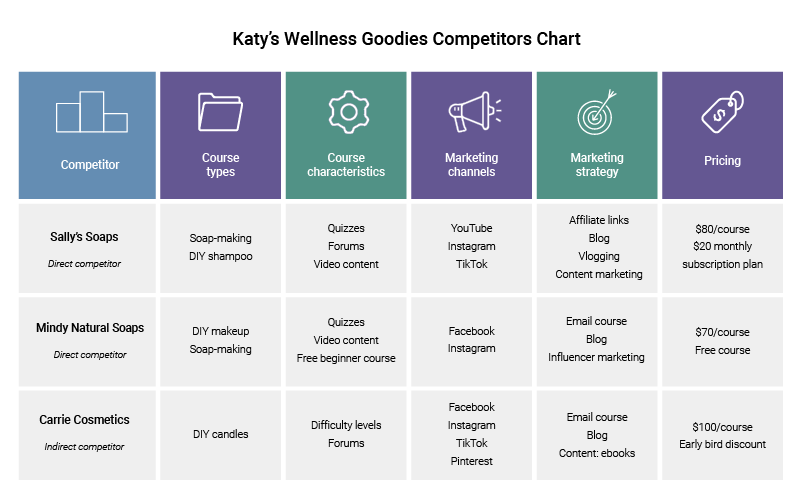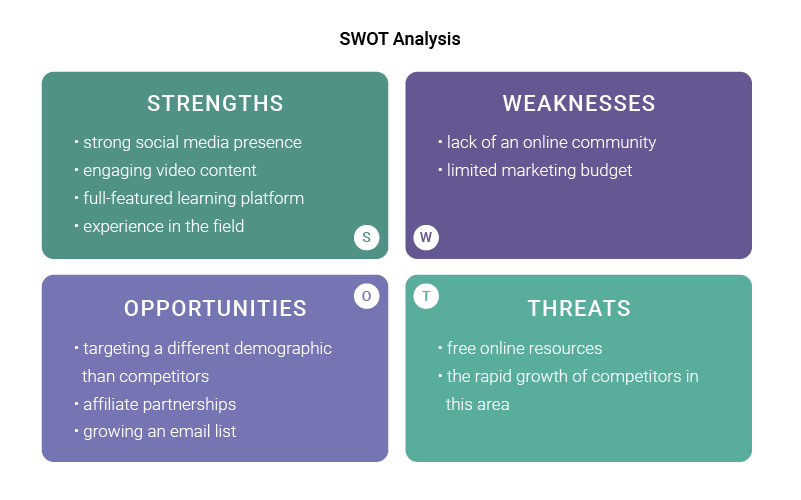There are many benefits to researching your competition, which I have discussed here, so make sure to check that out first.
Now, maybe you’re at that stage in which you’re ready to start doing competitive analysis, which in the e-learning space can be a bit intimidating. Online learning has grown by 900% since the year 2000. People have spent more time at home because of the pandemic, so it’s now more popular than ever.
Consequently, many courses exist out there, and many people want to become course creators to increase their revenue. You need to put in more effort to stand out from the crowd, so it’s essential to know where you’re standing right now and what you can do to grow.
Here are the steps you need to take to complete a thorough and productive competitive analysis:
Identify your competitors
Let’s say you’re teaching Business English to non-native speakers. A direct competitor is someone who has similar courses. An indirect competitor is someone who teaches Conversational English to non-native speakers. The indirect competitor may decide one day to create a Business English course as well, in which case they become your direct competitor. The last example can become a reality anytime as instructors continuously search for new opportunities.
In summary, there are two types of competitors to look for:
- Direct competitors have similar products and target the same learners;
- Indirect competitors target the same learners but have different products or vice versa.
To find your competition, search for courses on popular e-learning platforms. You can also use a platform that finds content, such as Buzzsumo. Narrow down your results by picking specific keywords — searching for “Business English for Spanish speakers” is more helpful and retrieves more relevant results than “English courses.” It all depends on your initial course idea and which niche you want to pursue.
Analyze their brand
Be curious and pretend that you’re a prospective learner. Take stock of everything you can find related to their brand. Find all the channels that they use to market their courses, especially their main website.
- Do they have a consistent color scheme?
- Can you easily find information about them and their courses?
- Is the website easy to navigate? What do you think about the course landing pages?
- Do they have an online community?
- Do people engage with their posts and content? How often?
- Do they use social proof such as endorsements and reviews or even testimonials?
- Do they have a remarkable story, a unique background that people might find inspiring?
Try to find anything that you like or maybe dislike. You don’t have to copy what your competitors do, but doing this exercise will help you decide what you want your brand to look like, what you are missing. You can also figure out what to invest in — for example, designing or commissioning someone to create a better logo for your business.
Read more: 6 Personal branding tips for knowledge entrepreneurs
Analyze their courses
Are your competitors doing something unique? Could you do something different with the format, interactivity, and content? These are all questions that you should ask yourself before creating your course or when you’re promoting it. In this way, you can identify something unique about your product and use it to your advantage.
- Does their e-learning platform stand out in any way?
- Do their courses have something interesting such as gamification, or communication venues such as forums?
- Do they do videos in addition to written content?
Have a look at the types of assessments that they use, if at all. Also, it helps to look at the difficulty of a course. This information is usually available on their website for free, so it’s a matter of examining the course description and outline.
Analyze their marketing strategy
We’ve partially discussed this at step two, but it’s also important to see which tactics your competitors use the most and how. Here you can use the main website/ social media pages and take note of:
- Do they have well-designed landing pages? Is there something they do well, such as placing the subscription form in a convenient location?
- Where can you find them on social media? How often and what do they post?
- What is their content marketing strategy like? Do they offer white papers, infographics, ebooks? How do you appreciate their quality?
- Do they have a blog? What and how often do they post, do they collaborate with others?
- Can you find anything related to their email marketing strategy? Do they have an email course to attract more learners?
- Is there any free content such as free courses? Do they host giveaways to grow their customer base?
- Is there any information about affiliate and influencer marketing? Do other people talk about them on various platforms such as blogs and social media?
This research will come in handy when you create your marketing strategy or if you need to improve what you’re currently doing.
Analyze their pricing strategy
Analyzing your competitors’ pricing strategy is about learning how to charge a fair price and figuring out how to make your courses more valuable. In this way, you can justify charging what you need to charge for your time and effort.
Read more: How to set a price for your online course
The biggest trap you could fall into is setting a low price because you see others do it. The thinking behind this is that if your course is cheaper, then they’ll come to you instead of them! That’s not necessarily true since you need to invest money to attract learners in the first place. Plus, you might get into a vicious circle of pricing your courses lower and lower.
Here’s the gist: there will always be a cheaper or even free course out there. Some instructors might charge as low as $10 and attract learners who are only willing to pay $10 all the time. In the long run, this is bad for your business.
It’s also important to see if your competitors offer a subscription plan, bundles, discounts, limited offers — these are opportunities for you to attract learners that won’t pay the entire sum but will take advantage of discounts.
Read more: 4 Types of online learning products you could be selling right now
Keep track of important data
You can find all sorts of templates and techniques out there and do what works best for you. I think that keeping a simple spreadsheet or table does the job. Just make sure that you include the information that you need the most.

If you need to go more in-depth in certain areas, such as Marketing, no problem: just create a separate table/spreadsheet with different rows: Email, Affiliate, Content, Social media marketing, etc.
Identify what you can improve
You can do this step even if you haven’t launched your course yet, but it does help to have at least something in place: a learning platform, course content, social media presence, etc.
Your research can’t help you if you don’t put it to good use. Specifically, see what you already do well, what you don’t do so well and what you can improve. Yes, I am talking about a good old SWOT analysis:
- Strengths - what you already have and what you do well, even better than competitors
- Weaknesses - what you don’t do/have compared to them
- Opportunities - what you can take advantage of, external resources
- Threats - anything related to the competition and other external factors that can threaten your business

Once you do this, it’s time to use the strengths to market your courses and the opportunities to grow your business.
Monitor frequently
This initial review can surely change, considering that competitors change their products and tactics over time. There isn’t a golden rule for doing competitive research. You can do this a few times per year or whenever you want to release something new, change something to your website, or you want to change your marketing strategy.
To stay on top of things, it helps to monitor their presence constantly. You can set up Google Alerts to receive daily updates. Some websites monitor brand mentions so you can keep up with what they do.
If you feel like this is too much, subscribe to their blogs and follow their social media pages — you never know when something relevant comes up.
Wrapping up
Analyzing your competition boils down to identifying who they are, what they do, and see what you can do better or differently. Doing this will help you a lot and give you that competitive edge needed to grow your business. Find your strengths and play your cards well, as they say.
Plus, a competitive analysis shows how important it is not to dismiss your competitors and what they do. You have something to learn from each one of them as everyone has something to offer.







